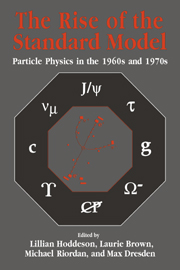Book contents
- Frontmatter
- Contents
- Contributors
- Editors' Acknowledgments
- Photographs of the Symposium
- Abbreviations and Acronyms
- Mathematical Notation
- Part One Introduction
- Part Two Quarks and Leptons
- Part Three Toward Gauge Theories
- Part Four Accelerators, Detectors, and Laboratories
- Part Five Electroweak Unification
- Part Six The Discovery of Quarks and Gluons
- 29 Early Baryon and Meson Spectroscopy Culminating in the Discovery of the Omega-Minus and Charmed Baryons
- 30 Quark Models and Quark Phenomenology
- 31 From the Nonrelativistic Quark Model to QCD and Back
- 32 Deep-Inelastic Scattering and the Discovery of Quarks
- 33 Deep-Inelastic Scattering: From Current Algebra to Partons
- 34 Hadron Jets and the Discovery of the Gluon
- Part Seven Personal Overviews
- Index
31 - From the Nonrelativistic Quark Model to QCD and Back
Published online by Cambridge University Press: 03 February 2010
- Frontmatter
- Contents
- Contributors
- Editors' Acknowledgments
- Photographs of the Symposium
- Abbreviations and Acronyms
- Mathematical Notation
- Part One Introduction
- Part Two Quarks and Leptons
- Part Three Toward Gauge Theories
- Part Four Accelerators, Detectors, and Laboratories
- Part Five Electroweak Unification
- Part Six The Discovery of Quarks and Gluons
- 29 Early Baryon and Meson Spectroscopy Culminating in the Discovery of the Omega-Minus and Charmed Baryons
- 30 Quark Models and Quark Phenomenology
- 31 From the Nonrelativistic Quark Model to QCD and Back
- 32 Deep-Inelastic Scattering and the Discovery of Quarks
- 33 Deep-Inelastic Scattering: From Current Algebra to Partons
- 34 Hadron Jets and the Discovery of the Gluon
- Part Seven Personal Overviews
- Index
Summary
Speaking of the birth, in 1969, of the parton model, David Gross wrote: “From then on I was always convinced of the reality of the quarks, not just as mnemonic devices for summarizing hadron symmetries, that they were then universally regarded to be, but as physical pointlike constituents of the nucleon” (italics mine). In a letter of reply (note 1) I noted that while it is hard to predict how the notion of quarks will evolve, it is sure that - already since 1965 – their most productive description was a realistic one.
In a review article about the discovery of quarks, Michael Riordan stated: “After several years of fruitless searches most particle physicists agreed that although quarks might be useful mathematical constructs, they had no innate physical reality as objects of experience.” Again I disagree. For many people trying to understand the remarkable developments of hadron spectroscopy, the quarks of the nonrelativistic quark model (NRQM) were, already five years before partons, not a mathematical construct or a mnemonic device but something very realistic. I started a long experiment (from 1965 to 1982) to search for real free quarks because of the quantitative results (well beyond group theory) that I had obtained with the NRQM.
Of course in that period many theorists did not like the NRQM. As one example, at Vienna in 1968 my rapporteur talk (note 6) on the NRQM was inserted in the session on “Current Algebra.”
- Type
- Chapter
- Information
- The Rise of the Standard ModelA History of Particle Physics from 1964 to 1979, pp. 561 - 565Publisher: Cambridge University PressPrint publication year: 1997
- 1
- Cited by



